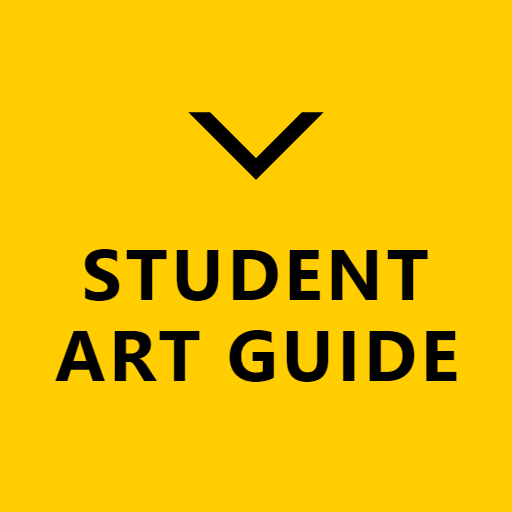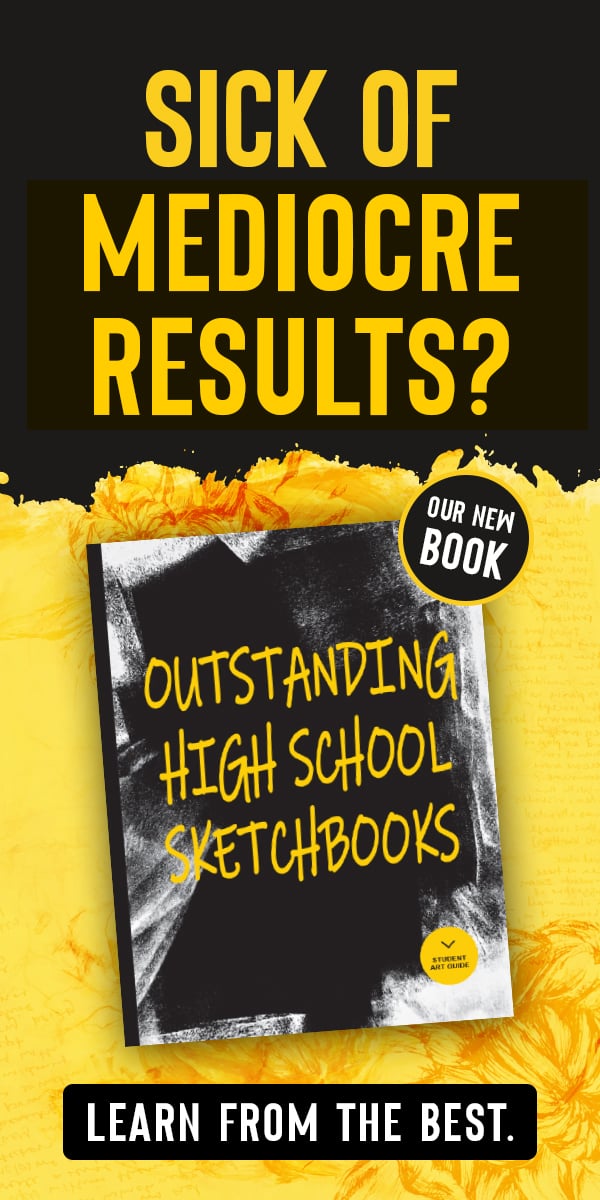Last Updated on April 2, 2023
This article features the International Baccalaureate Exhibition Work, Comparative Study and Process Portfolio of Enrico Giori, completed as a part of the IB Diploma Programme at the St. Louis School of Milan. The work is that of the new IB Visual Arts syllabus 2016, which was examined for the first time in May. Enrico was awarded a level 7 at IB Visual Arts HL, obtaining full marks in all three components of the course. Through a comprehensive investigation of the figure of the 1950s stereotype of the “Happy Homemaker”, Enrico develops both a conceptually and technically strong body of work, underpinned by thorough investigation in his Process Portfolio and in-depth artwork analysis in his Comparative Study.
Two of Enrico’s sketchbook pages are included in our new book: Outstanding High School Sketchbooks. This book has high-resolution images so that fine details and annotation are clear, making it an excellent resource for students and schools. Learn more!

Enrico has answered some questions about his IB Visual Arts experience below, covering all three components of the course.

The body of work that you have developed is based upon a particular theme: the stereotype of the 1950s homemaker. Can you outline how you got to this theme and what types of ideas you have explored in your work?
Gender inequality is an issue that I feel extremely strongly about, and, in my IB Visual Arts body of work, I have decided to explore one of the most plastic images of women: the housewife. By employing irony, humour and storytelling, I have been able to explore the veil of ridiculousness that makes the 1950s inspired stereotype of the joyful, perennially well-dressed and smiling woman nothing but a “self-made hell”. Through my work I tried to show how women are often unable to fully develop their own person and tailor the roles of housewife, professional, mother and so on to their own vision of their own lives.
Although my whole body of work revolves around this very intricate conceptual framework, I actually got to the figure of the housewife by investigating the anatomy of the human hand in my Process Portfolio at first, which led me to produce observational studies of dish washing gloves, which inevitably led my thinking to the domestic environment.

How have your IB Visual Arts Process Portfolio and Visual Journal helped you develop your body of work, and what advice do you have for future and present Visual Arts students when it comes to their PP?
The Visual Journal, which I then edited and digitally re-assembled to form my Process Portfolio, was fundamental in my Visual Arts journey: not only did it enable me to brainstorm, test and refine ideas, but it also allowed me to reflect on my art making and critically analyse my work and that of artists who I have investigated. One of my main pieces of advice for the Visual Journal (and the Process Portfolio which is then submitted for assessment) is to ensure that it clearly represents your thought process when it comes to art making. The assessment criteria for this component clearly states that you should be showing your ideas both using written text and visuals. Don’t be too dependent on text to convey your thoughts, as this may hinder the strength of your imagery and concepts. Diagrams, photos of the art-making process and quick sketches may help you convey important information to the examiner.

Has your Comparative Study also informed your work? If yes, how has it done so?
My Comparative Study has greatly informed my work, especially because it allowed me to explore different pieces of art from different cultural, historical and social contexts. I selected three pieces of art, which were rather different one from the other: Rebecca Horn’s Finger Gloves (1972), André Kertész’s Paul Arma’s Hands (1928) and a Japanese ukiyo-ye print by an unknown artist, entitled Courtiers With A Lady (1820 approx.)
Despite the pieces being extremely different, I didn’t find it too challenging to identify similarities and differences between them. For instance, one of my comparisons was solely based on the formal elements of the pieces, whilst another was based around a more conceptual reflection on gender inequality and its portrayal in art. At HL, Students should connect the artworks compared in the Comparative Study to their own work, and this section of my Comparative Study really helped me analyse critically my own pieces, comparing my methods of delivering my concept to those of three different artists from differing cultures and times.

Which artists have influenced your work mostly? Have you been also influenced by other sources, such as popular media, literature and so on?
I have committed myself to include a female perspective in my pieces, and to try and employ art-making techniques that utilize unconventional mediums, such as stitching, embroidery and innovative sculpture forms. Feminist artists such as Martha Rosler, Rebecca Horn and Cindy Sherman have been inspirational to me in terms of conceptual values, whilst other artists such as Man Ray, Egon Schiele and William Kentridge have impacted my work both conceptually and formally. This has allowed me to develop a drawing and painting style that I hope I can call my own. Popular culture and literature have also influenced my work. 1950s advertisements helped me create a convincing image of housewives, and other sources, such as Lady GaGa’s music video Telephone, have conceptually informed my work. I have chosen to connect each of my pieces to a quote from Carol Ann Duffy’s The World’s Wife (available from Amazon), an anthology of feminist poetry that gives voice to all the silenced women who accompanied the most important men of history. Duffy’s boiling anger towards men and their pretentiousness, which is expressed in her compositions through humour, satire and popular contemporary imagery, reflects much of my own portrayal of gender disparity.
The video above is one of the pieces Enrico included in his final exhibition. The video draws upon many different sources, such as Lady GaGa’s music video “Telephone”, Martha Rosler’s “Semiotics of the Kitchen” and popular imagery from the fifties. Enrico filmed the video, edited the footage, added some public domain 1950s music from the movie D.O.A. and recorded his own voiceover, altering a script from a real 1950s instructional film for women, “Marriage is a Partnership”. Although the IB does not assess audio in the Visual Arts course, the soundtrack was useful in terms of establishing a connection with the audience at the opening of the exhibition. The relationship with the viewer, explained in the Curatorial Rationale, is assessed at IB.
In your exhibition work you use a range of mediums and techniques, some common and others a lot less traditional. How have your choices of mediums and techniques informed your work?
I have always enjoyed exploring and experimenting with techniques and mediums, mixing and combining to create something personal. For this body of work I have embraced stereotypical female craft forms such as dressmaking, embroidering and stitching and combined these with printing, drawing and painting. Materials and tools have also been derived from the domestic environment. Soap bars, bleach, vinyl embossed tablecloths used in frottage, fabric and wallpaper from my own designs, combined with traditional charcoal, ink, acrylic and printmaking characterize my work. Digital imagery has also played an important role and photography and video allowed me to portray my subject in action, allowing for the smooth development of a storyline.
Using unconventional mediums such as household cleaning supplies wasn’t easy at first, but these materials really allowed me to produce a body of work that portrays my concept in full.

Do you have any further advice both for current and future IB Visual Arts Students?
Visual Arts is a tough course at IB, but with discipline, a good work ethic and the will to set aside quite a considerable amount of time, you are well positioned to succeed. Also, try and develop a love for criticism: your work will be periodically critiqued, and although some critiques may not be easy to take at first, they will help you in the long run. You don’t want to know what my body of work would have looked like if I hadn’t considered some of the critiques I got from my teacher and friends! Monitoring progress is exceptionally important, and I was greatly assisted in monitoring my own growth by Heather McReynolds’ Self Assessment Rubrics that she posted on the ThinkIB Visual Arts website. This subscription site for schools contains a wealth of useful information, and many art teachers use it already (this is one of the websites mentioned on the Student Art Guide list of great websites for Art teachers). Furthermore, I would like to tell anyone embarking on this course to never be afraid of thinking “too big”. Back at the start of IB I would have never imagined I would have created a 2.3 metre tall drawing, a painting using bleach and an installation made out of soap bars, a doormat and magazine clippings – but it turns out that by the end of my course I actually did all these things!
One piece of advice I would like to leave anyone reading this article with is to always love what you do, because if you do so, whatever you are doing will show love right back. I spent several hours every day working on my IB Visual Arts work, and I must admit that seeing everything completed on the day of the opening of the final exhibition made it all worth it.


If you enjoyed Enrico’s IB art project, you may also wish to view his A* IGCSE Coursework and IGCSE Examination project.

